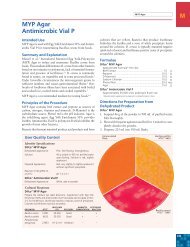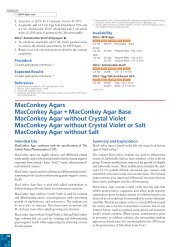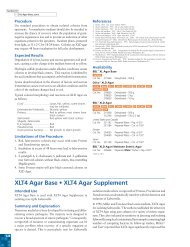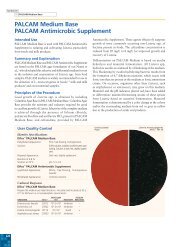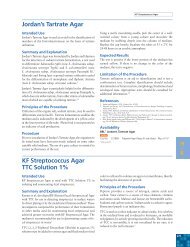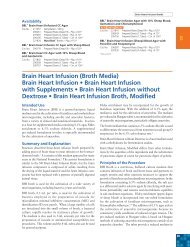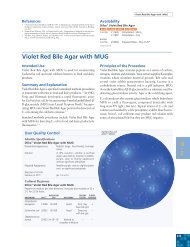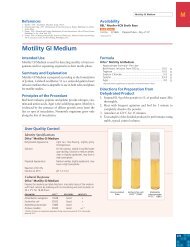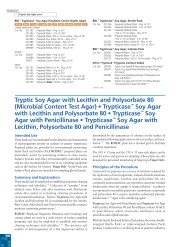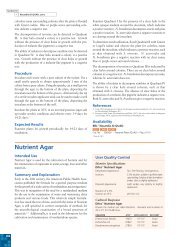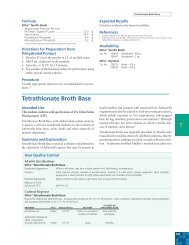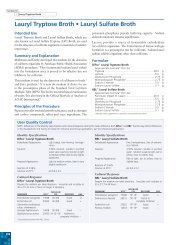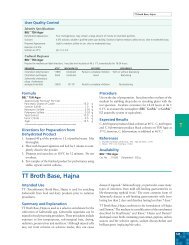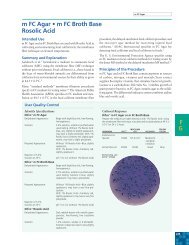Universal Beer Agar - BVA Scientific
Universal Beer Agar - BVA Scientific
Universal Beer Agar - BVA Scientific
Create successful ePaper yourself
Turn your PDF publications into a flip-book with our unique Google optimized e-Paper software.
Section III<br />
U-Z UVM Modified Listeria, cont.<br />
Expected Results<br />
Refer to appropriate references and procedures for results.<br />
References<br />
1. Murray, Webb and Swann. 1926. J. Pathol. Bacteriol. 29:407.<br />
2. Monk, Clavero, Beuchat, Doyle and Brackett. 1994. J. Food Prot. 57:969.<br />
3. Wehr. 1987. J. Assoc. Off. Anal. Chem. 70:769.<br />
4. Bremer and Osborne. 1995. J. Food Prot. 58:604.<br />
5. Grau and Vanderlinde. 1992. J. Food Prot. 55:4.<br />
6. Patel, Hwang, Beuchat, Doyle and Brackett. 1995. J. Food Prot. 58:244.<br />
7. Ryser and Donnelly. 2001. In Downes and Ito (ed.), Compendium of methods for the microbiological<br />
examination of foods, 4th ed. American Public Health Association, Washington, D.C.<br />
8. Kramer and Jones. 1969. J. Appl. Bacteriol. 32:381.<br />
9. Donnelly and Baigent. 1986. Appl. Environ. Microbiol. 52:689.<br />
10. McClain and Lee. May 24, 1989. Laboratory communication No. 57. Microbiology Division, Food<br />
Safety and Inspection Service, U.S. Department of Agriculture, Beltsville, Md.<br />
11. Bille, Rocourt and Swaminathan. 1999. In Murray, Baron, Pfaller, Tenover and Yolken (ed), Manual<br />
of clinical microbiology, 7th ed. American Society for Microbiology, Washington, D.C.<br />
12. Hayes, Graves, Swaminathan, Ajello, Marcolm, Weaver, Ransom, Deaver, Plikaytis, Schuchat, Wenger,<br />
Pinner, Broome and The Listeria Study Group. 1992. J. Food. Prot. 55:952.<br />
Availability<br />
Difco UVM Modified Listeria Enrichment Broth<br />
AOAC COMPF<br />
Cat. No. 222330 Dehydrated – 500 g<br />
222310 Dehydrated – 2 kg<br />
222320 Dehydrated – 10 kg<br />
<strong>Universal</strong> <strong>Beer</strong> <strong>Agar</strong><br />
Intended Use<br />
<strong>Universal</strong> <strong>Beer</strong> <strong>Agar</strong> (UBA Medium) is used for cultivating<br />
microorganisms of significance in the brewing industry.<br />
Summary and Explanation<br />
<strong>Universal</strong> <strong>Beer</strong> <strong>Agar</strong> is a basal medium to which beer is added.<br />
It is based on the formula developed by Kozulis and Page 1<br />
who compared it with other media commonly used in breweries<br />
for detecting microbial contamination. 2 The characteristics of<br />
<strong>Universal</strong> <strong>Beer</strong> <strong>Agar</strong> are closer to the natural environmental<br />
conditions found in the typical brewery than other media studied.<br />
It supports growth of more varieties of lactic acid bacteria and<br />
yields larger colonies in a shorter time than traditional brewer’s<br />
media. Due to the presence of beer in the medium, it is<br />
selective for growth of microorganisms that have adapted<br />
User Quality Control<br />
Identity Specifications<br />
Difco <strong>Universal</strong> <strong>Beer</strong> <strong>Agar</strong><br />
Dehydrated Appearance: Medium beige, homogeneous, freeflowing.<br />
Solution:<br />
6.2% solution, soluble in purified<br />
water upon boiling. Solution is medium<br />
to dark amber, very slightly opalescent.<br />
Prepared Appearance: Medium to dark amber, very slightly<br />
opalescent.<br />
Reaction of 6.2%<br />
Solution at 25°C: pH 6.3 ± 0.2<br />
Cultural Response<br />
Difco <strong>Universal</strong> <strong>Beer</strong> <strong>Agar</strong><br />
Prepare the medium per label directions. Inoculate and incubate at<br />
30 ± 2°C for up to 3 days.<br />
ORGANISM ATCC INOCULUM CFU RECOVERY<br />
Acetobacter pasteurianus 12879 10 2 -10 3 Good<br />
Lactobacillus fermentum 9338 10 2 -10 3 Good<br />
Lactobacillus johnsonii 11506 10 2 -10 3 Good<br />
Pediococcus acidilactici 8081 10 2 -10 3 Good<br />
themselves to existent conditions in the brewery. The presence<br />
of hop constituents and alcohol inhibits growth of many airborne<br />
microorganisms not adapted to this environment. 3<br />
<strong>Universal</strong> <strong>Beer</strong> <strong>Agar</strong> supports growth of Lactobacillus,<br />
Pediococcus, Acetobacter and yeast strains which may be found<br />
contaminating the wort and beer.<br />
Principles of the Procedure<br />
Yeast extract is a source of trace elements, vitamins and amino<br />
acids. Peptonized milk contains lactose as an energy source.<br />
Tomato juice is a source of carbon, protein and nutrients.<br />
Dextrose provides additional carbon. Dipotassium and<br />
monopotassium phosphates provide buffering capability.<br />
Magnesium sulfate, ferrous sulfate and manganese sulfate are<br />
sources of ions that stimulate metabolism. Sodium chloride<br />
provides essential ions. <strong>Agar</strong> is the solidifying agent.<br />
Formula<br />
Difco <strong>Universal</strong> <strong>Beer</strong> <strong>Agar</strong><br />
Approximate Formula* Per Liter<br />
Yeast Extract .............................................................. 6.1 g<br />
Peptonized Milk ....................................................... 15.0 g<br />
Tomato Juice (from 244 mL) ..................................... 12.2 g<br />
Dextrose ................................................................... 16.1 g<br />
Dipotassium Phosphate .............................................. 0.31 g<br />
Monopotassium Phosphate ........................................ 0.31 g<br />
Magnesium Sulfate .................................................... 0.12 g<br />
Sodium Chloride ........................................................ 6.0 mg<br />
Ferrous Sulfate ........................................................... 6.0 mg<br />
Manganese Sulfate .................................................... 6.0 mg<br />
<strong>Agar</strong> ......................................................................... 12.0 g<br />
*Adjusted and/or supplemented as required to meet performance criteria.<br />
Directions for Preparation from<br />
Dehydrated Product<br />
1. Suspend 62 g of the powder in 750 mL of purified water<br />
(or halogen-free tap water). Mix thoroughly.<br />
2. Heat with frequent agitation and boil for 1 minute to<br />
completely dissolve the powder.<br />
3. While the medium is still hot, add 250 mL commercial beer<br />
(not degassed) and mix well.<br />
604
<strong>Universal</strong> Preenrichment Broth<br />
4. Autoclave at 121°C for 10 minutes.<br />
5. Test samples of the finished product for performance using<br />
stable, typical control cultures.<br />
Procedure<br />
See appropriate references for specific procedures.<br />
Expected Results<br />
Refer to appropriate references and procedures for results.<br />
References<br />
1. Kozulis and Page. 1968. Proc. Am. Soc. Brewing Chemists, p. 52.<br />
2. Murphy and Saletan. 1970. Tech. Q. Master Brew. Assoc. Am. 7:182.<br />
3. MacFaddin. 1985. Media for isolation-cultivation-identification-maintenance medical bacteria, vol.<br />
1. Williams & Wilkins, Baltimore, Md.<br />
Availability<br />
Difco <strong>Universal</strong> <strong>Beer</strong> <strong>Agar</strong><br />
Cat. No. 285610 Dehydrated – 500 g<br />
Mexico<br />
Cat. No. 252644 Prepared Plates (60 × 15 mm-style) – Pkg. of 20*<br />
*Store at 2-8°C.<br />
<strong>Universal</strong> Preenrichment Broth<br />
Intended Use<br />
<strong>Universal</strong> Preenrichment Broth is used for recovering sublethally<br />
injured Salmonella and Listeria from food products.<br />
Summary and Explanation<br />
Traditional methods for recovering Salmonella and Listeria<br />
from food products require separate preenrichment media for<br />
each microorganism. 1,2 Some broth media recommended<br />
for preenrichment contain antibiotic inhibitors 3 or have<br />
insufficient buffering capacity which hinder recovery of sublethally<br />
injured cells. 3-5<br />
Bailey and Cox 3 formulated <strong>Universal</strong> Preenrichment Broth to<br />
permit simultaneous resuscitation of sublethally injured<br />
Salmonella and Listeria. The broth medium provides sufficient<br />
buffering capacity to prevent rapid decreases in pH and<br />
allows for repair of injured cells that might be sensitive to low<br />
pH values or inhibitory substances.<br />
Principles of the Procedure<br />
<strong>Universal</strong> Preenrichment Broth contains peptones as sources<br />
of carbon, nitrogen, vitamins and minerals. Sodium and<br />
potassium phosphates buffer the medium. Sodium chloride<br />
maintains the osmotic balance of the medium. Magnesium<br />
sulfate and ferric ammonium citrate provide essential ions.<br />
Dextrose is an energy source. Sodium pyruvate helps stimulate<br />
the metabolism of stressed organisms.<br />
User Quality Control<br />
Identity Specifications<br />
Difco <strong>Universal</strong> Preenrichment Broth<br />
Dehydrated Appearance: Light beige, free-flowing, homogeneous.<br />
Solution:<br />
3.8% solution, soluble in purified<br />
water. Solution is light to medium<br />
amber, slightly opalescent to opalescent,<br />
may have a precipitate.<br />
Prepared Appearance: Light to medium amber, slightly opalescent<br />
to opalescent, may have a<br />
precipitate.<br />
Reaction of 3.8%<br />
Solution at 25°C: pH 6.3 ± 0.2<br />
U -<br />
Z<br />
Cultural Response<br />
Difco <strong>Universal</strong> Preenrichment Broth<br />
Prepare the medium per label directions. Inoculate and incubate at 35 ±<br />
2°C for 18-24 hours.<br />
ORGANISM ATCC INOCULUM CFU RECOVERY<br />
Listeria monocytogenes 19115 10-10 2 Good<br />
Salmonella choleraesuis subsp.<br />
choleraesuis serotype Enteritidis 13076 10-10 2 Good<br />
Salmonella choleraesuis subsp.<br />
choleraesuis serotype Typhimurium 14028 10-10 2 Good<br />
Uninoculated<br />
Tube<br />
Salmonella<br />
typhimurium<br />
ATCC 14028<br />
605



